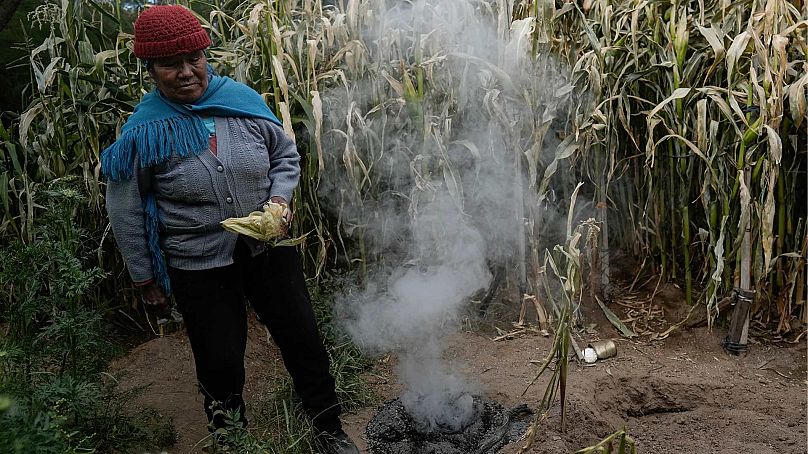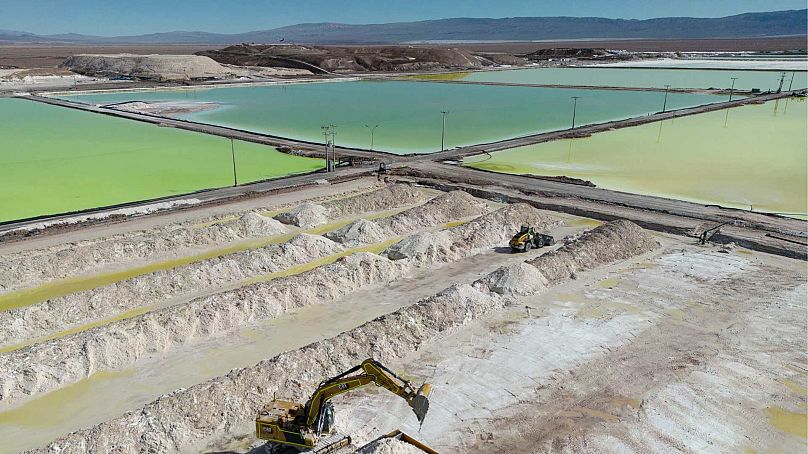Native groups in South America sit on $1 trillion of lithium but at what cost to their water, culture and livelihoods?
The ‘lithium triangle’ – spanning Argentina, Chile and Bolivia – is home to the largest reserve of lithium anywhere on Earth.
This metal is key in the transition to net zero, used in electric car batteries, crucial to solar and wind energy and much more.
But to extract it, mines suck water out of the white salt flats that cover this land. Land that has sustained thousands of Indigenous communities that have lived within here since before Elon Musk was but a glint in his mother’s eye.
Skip Ad
Continue watchingafter the adVisit Advertiser websiteGO TO PAGE
PLAY  Latest
Latest
Video Settings
Full Screen
About ConnatixV461608 Read More
Read More Read More
Read More Read More
Read More Read More
Read More Read More
Read More Read More
Read More Read More
Read More Read More Two of the world’s top 100 beaches are in Europe -and they’re not in Spain or Portugal
Read More Two of the world’s top 100 beaches are in Europe -and they’re not in Spain or Portugal (new Image()).src = ‘https://capi.connatix.com/tr/si?token=604675c4-ea89-46c9-9817-5ed115e7bf41&cid=83b16131-8326-440c-9a78-470bcd2870e2’; cnxps.cmd.push(function () { cnxps({ playerId: “604675c4-ea89-46c9-9817-5ed115e7bf41” }).render(“29572e93412441b3b0dc992bd9167d8a”); });
(new Image()).src = ‘https://capi.connatix.com/tr/si?token=604675c4-ea89-46c9-9817-5ed115e7bf41&cid=83b16131-8326-440c-9a78-470bcd2870e2’; cnxps.cmd.push(function () { cnxps({ playerId: “604675c4-ea89-46c9-9817-5ed115e7bf41” }).render(“29572e93412441b3b0dc992bd9167d8a”); });
As the world’s most powerful increasingly look to the triangle as a crucial puzzle piece in their plans, many worry the search for lithium will mean sacrificing that very life force that has sustained the region’s native people for centuries.
**How do we live without fresh water to drink?
**
Irene Leonor Flores de Callata’s native Kolla people have spent centuries climbing deep into the mountains of northern Argentina in search of a simple substance: fresh drinking water.
The parched waterways surrounding their town are intrinsically connected with spanning white salt flats below, subterranean lagoons with waters jam-packed with the material that’s come to be known as “white gold” – lithium.
“We will lose everything,” says Flores de Callata, 68, as she treks along a bone-dry riverbed, guiding a herd of llamas and sheep through stretching desert.
“What will we do if we don’t have water? If the mines come, we’ll lose our culture, we won’t be left with anything.”
Here, in one of the most arid environments in the world, water is a life force that underpins everything.
Lithium: The material of the moment
Between 2021 and 2023, the price for one ton of lithium in US markets nearly tripled, reaching a high of $46,000 (€42,000) a ton last year, according to a United States Geological Survey report.
In China, the main customer of the region’s lithium, a ton of the metal went for a whopping $76,000 (€69,000) at its peak last year.
While prices have since dipped, leaders, mining executives and companies from across the world began to turn their heads. From the US and China, they looked to the region’s barren deserts both as a source of wealth and an engine to power the transition to green energy.
Lithium is extracted from salt flats
The “white gold” they seek is contained in the hundreds of salt flats, or ‘salares’, speckling the region.
From afar, they look like fields of Arctic snow, but below are deep wells of salted groundwater packed with minerals. Unlike other forms of mining, lithium here is extracted not from rock, but rather from the brine water pumped from the salt flats.
The problem is that the salt flats also act as an essential part of a highly biodiverse ecosystem, say scientists like Ingrid Garcés, a hydrologist from Chile’s University of Antofagasta.
While the water inside the lagoons is not drinkable, they are tethered to surrounding fresh water sources, sparse rains and nearby mountain streams, essential for the survival of thousands of Indigenous communities.
The concern by scientists, interviewed by the Associated Press agency, is that industrial-scale water pumping both contaminates fresh water with brine they pump and effectively dries up the surrounding environment. They say it’s produced cascading ripple effects for life in the region at a time it’s already been hit by climate change-induced drought.
Growing tired of fending off mining companies
Because of their environmental significance, the salt flats and their surrounding waters have gained a sacred place for Indigenous cultures, an essential part of native celebrations the entire month of August.
Flores de Callata’s town is one of 38 pressed up against two such salt flats – the Guayatayoc lagoon and Salinas Grandes – which bring income to towns like hers through tourism and small-scale salt harvesting.
For decades, their collective of communities have fought off large-scale mining and waged long legal battles to halt projects.
But year by year, it’s grown more difficult to fend off those mining companies.
More than 30 companies are officially seeking permission to mine the water in the two salt flats. Signs put up by the community line the edges of the flats reading, “Respect our territory. Get out, lithium company.”
“We are guardians of the highlands,” said Flores de Callata. “We defend our land. … I’m worried not just for myself but for all of us. If the lithium (mines) come it’s going to affect the entire region, all of the waterways by extension.”
Has the local government violated international law by allowing mining?
Things came to a head last summer when the local government, eager for the profits by the mines, changed its constitution, making it easier to waive certain Indigenous land rights and limiting the ability to protest against the expansion of mining.
Alicia Chalabe, the environmental lawyer representing the communities, and others argue the move violates international law.
Thousands of Indigenous people erupted in protest, blocking off roadways used by lithium mines and carrying rainbow-coloured Indigenous flags.
Doors for the mining companies have been left wide open under the country’s new right-wing “anarcho-capitalist” leader Javier Milei, who was elected in November, under a promise to fix his country’s spiraling economy.
The chainsaw-wielding leader has announced a broad deregulation sweep, slashing costs for mining companies in an effort to lure investors amid deepening economic crisis. Milei’s rise to power will likely further hamstring already fraught efforts by indigenous communities to beat back mining companies.
For Flores de Callata and her small town of Tusaquillas, the mounting interest in their home represents another nightmare scenario.
She wonders what will be left in 20 years.
“If the mines come, we’ll have money for a time. But then our grandchildren, our great-grandchildren – they’re the ones who will suffer,” she said. “I want to do everything possible to defend these lands, so they still have these fields, so they still have their waters.”
















